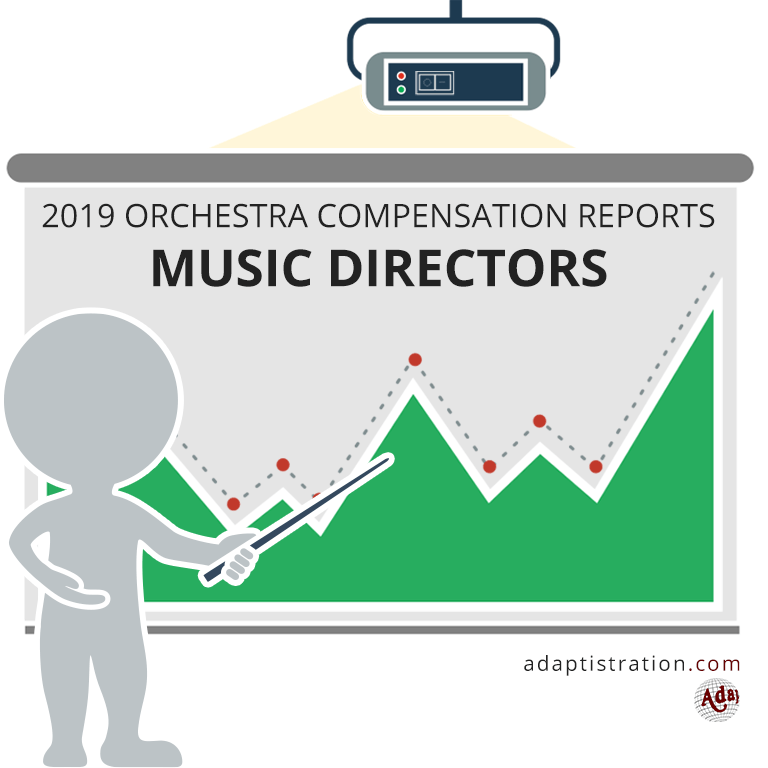If you were a music director during the 2016/17 season, there’s a good chance you had several hundred thousand good reasons to see it as a really good year and one conductor in particular had more than three million good reasons. But if we’re looking at things from middle out, music directors continued to maintain an average compensation rate in excess of $600,000.
The Information
In order to provide information that is as accurate as possible, info from the 2016/17 season is gathered from the following sources:
- Music Director compensation figures were obtained from their respective orchestra’s IRS Form 990 for the 2016/17 concert season.
- Total Expenditures were also obtained from each respective orchestra’s IRS Form 990 for the 2016/17 concert season.
Adaptistration makes no claim to the accuracy of information from documents compiled or reported by external sources. If you have reason to believe any of the information is inaccurate or has changed since reported in any of the above sources and you can provide documentation to such effect, please feel free to use the following form to submit a notice.
Did you know? Direct links to most of the orchestra’s financial disclosure documents at guidestar.org are available in the Orchestra Financial Reports or you can save yourself dozens of hours by picking them up by season at the Adaptistration Store since the information is no longer available here.
What The Numbers Don’t Show
It is important to remember that the numbers shown do not always convey a complete compensation picture. For example, a music director may have had a large increase in salary because they were leaving a position and per terms of their contract they may have received a sizeable severance or deferred compensation package. As such, the cumulative compensation may artificially inflate annual earnings. Furthermore, these figures may not reflect bonuses or other incentive payments, therefore underreporting what conductors may actually earn.
Also missing from the figures are expense accounts, lodging expenses, and other perks; as such, the cumulative compensation for music directors may or may not be more than what is listed. Additionally, the documents used to gather figures do not indicate how much of the season an individual received a salary. As such, excessive adjustments in the percentage change from the previous season’s compensation may be artificially adjusted. Although the music director compensation figures include the combined amounts reported as what the IRS classifies as Base Compensation, Bonus & Incentive Compensation, Other Reportable Compensation, Retirement And Other Deferred Compensation, and Nontaxable Benefits, each orchestra does not always report figures for the latter categories if paying the music director as an independent contractor.
How Employment Status Impact Compensation
Unlike executives, concertmasters, and musicians, music directors are sometimes employed as independent contractors. In these cases, orchestras will list the music director among the five highest paid independent contractors as opposed to sections devoted to employee compensation. In most of these instances, no information about benefits or deferred compensation is available.
Likewise, some music directors receive separate payments for duties associated with their position. For example, for several fiscal years the Seattle Symphony Orchestra paid former music director Gerard Schwarz via two separate private contractor listings: once for music director duties and the other for principal conducting duties. At the Baltimore Symphony, music director Marin Alsop is paid a fee for conducting services as an independent contractor and as an employee for non-conducting music director related duties and responsibilities.
In instances such as these, those figures have been combined into a single figure in the table below. For details about each individual conductor’s compensation, please consult the respective orchestra’s IRS Form 990.
2016/17 Season Music Director Compensation
Sorry, but this information is only made available for one year until the following season’s reports are published. Copies are available for a fee (feel free to inquire), or you can begin compiling your own database by building a comprehensive library of orchestra 990s, available from the Adaptistration Store.
Top 10 Earners
- Los Angeles Philharmonic: $3,010,589
- Chicago Symphony: $2,716,488
- San Francisco Symphony: $2,492,623
- Dallas Symphony: $2,206,908
- New York Philharmonic: $1,645,865
- Philadelphia Orchestra: $1,424,000
- Boston Symphony: $1,395,161
- Cleveland Orchestra: $1,319,353
- Saint Louis Symphony: $1,040,317
- Baltimore Symphony: $987,667

The “Not Reporteds”
One of the most positive aspects from this year’s report is the continuing decline in the number of Not Reported entries, which occurs when an organization’s 990 that should otherwise include music director compensation, doesn’t. In this case, it was the first such occurrence from The Louisville Orchestra. I’ve reached out to the organization to inquire about the missing compensation figure and we’ll update this article once they’ve been able to respond. Update (6/19/2019 4:30pm CT): the organization did reply and provided the figure now found in the chart.
But wait, there’s even more good news on this front in the form of a music director voluntarily offering up his compensation when it was otherwise obfuscated in the 990.
But in order to genuinely appreciate this significance, we need a fun lesson in how nonprofit performing arts organizations can screw over the spirit of fiscal transparency that serves as a cornerstone for IRS regulations realted to nonprofit tax filings.
When it comes to hiding music director compensation, one of the oldest tricks in the book is to pay the conductor as an independent contractor then make those payments to his/her artist management firm, such as Opus 3 Artists. The orchestra then mixes those dollars in with all the other dollars paid to guest artists managed by the same firm. The end result is you, the nonprofit donor and tax payer, have no way to fairly determine executive compensation.
If you think that sounds somewhat like money laundering, you may not be entirely inaccurate; except this isn’t technically illegal, it’s merely unethical and violates IRS regulations.
Now that everyone is up to speed on Shifty Compensation Bookkeeping 101, it’s time to get back to the good news.
One group with a history of using this tactic is the Phoenix Symphony. But here’s where it gets weird; this isn’t at the request of the conductor, it’s a decision made by the executive leadership and when it came to this season, the Phoenix Symphony’s music director, Tito Muñoz, volunteered to provide his compensation information directly. Muñoz not only provided the figure; he provided the verification. Moreover, he provided that information for every year he’s worked for the organization.
That’s a big deal in all the right ways.
Most music directors are simply ignorant of IRS reporting regulations when it comes to nonprofit executive compensation not to mention the reasons why that transparency exists.
I’m hoping Muñoz’s actions will be a spark that helps light the fire of increased discussion on this topic within the regular service organization channels as well as at the academic level, where aspiring conductors should be learning about the value of transparency.
Wouldn’t it be something to see this as a topic at next year’s League of American Orchestra or Opera America conferences?
Items Of Note
- LA Philharmonic music director Gustavo Dudamel’s compensation has always been somewhat of an outlier in that he has consistently earned less than his US peers at similarly sized budget orchestras. There have even been seasons where he earned less than the CEO, which is something that simply didn’t happen at the top end of the budget spectrum…until it did. But all that changed in 2016/17 where he rocketed to the tippy top of the earner list thanks to a 51 percent increase over the previous season’s compensation.
- Another music director that enjoyed a sharp increase was Osmo Vänskä, who saw a 31 percent increase in compensation. Having said that, the $981,630 is still lower than his all-time high compensation at the Minnesota Orchestra during the 11/12 season where he earned $1,183,720.
- This is more of a fun fact rather than an item of note, but the total amount earned by the Top 10 highest paid music directors was $18,238,971. This was only $3 million less than the average total expenditure of all the orchestras from this review ($21,311,267). For perspective, together, those 10 conductors earned more during the 2016/17 season than the Milwaukee Symphony Orchestra spent on, well, everything.


